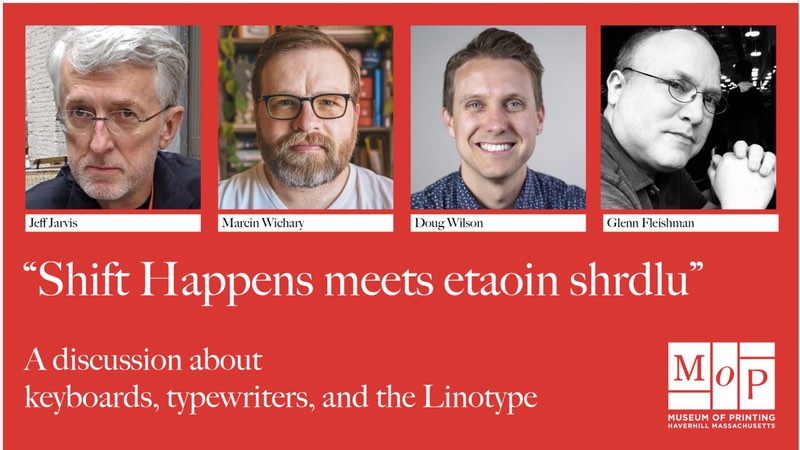“Shift Happens meets etaoin shrdlu”
A discussion about keyboards, typewriters, and the Linotype
Saturday, July 8 at 1:00 pm

Name the most important American inventions of the 19th century, and the typewriter and the Linotype will be up there with the sound recording, the telephone, and the sewing machine. The typewriter revolutionized personal and business correspondence, while the Linotype led the speed of putting words together and slapping them on newsprint to match the speed of news. Four experts come together at the Museum of Printing to talk about the heady years leading up to and during the 1870s and 1880s, when mechanical innovation and obsessive geniuses put typewriters and hot-metal composition into commercial production.
The event opens with short presentations by each panelist, then proceeds to a conversation among them about their areas of expertise, and finishes with a question-and-answer period with the audience.
Jeff Jarvis witnessed the transition from hot type to cold in newspapers. His first computer was an Osborne One, which is now part of the Museum of Printing’s collection. He founded Entertainment Weekly, the first major magazine to be produced on Macintoshes. He is the author of What Would Google Do? and Public Parts; of The Gutenberg Parenthesis, just out from Bloomsbury; and the upcoming Magazine, part of Bloomsbury’s Object Lessons series. He is a professor at the City University of New York’s Newmark Graduate School of Journalism and a host of the podcast This Week in Google.
Marcin Wichary is a writer, designer, and photographer. Later this year, he’s publishing Shift Happens, a two-volume textual and visual history of typing and keyboards from the earliest of typewriters to the modern mechanical marvels. He works as a design manager at Figma, and previously spent time at Medium (where he added support for the writing process tradition of adding TK), Google, and Code for America. He was born in Poland and currently lives in Chicago.
Doug Wilson is a designer, writer, filmmaker, and typographic historian. In 2012, he created Linotype: The Film, which documented the personal and professional impact of the Linotype on the world. He recently announced his Linotype Book Project, which will tell a more complete story of the Linotype’s impact on society through new research and never-before-seen images and ephemera. He lives and cycles in Denver, Colorado.
Glenn Fleishman began his working life as a phototypesetter in the 1980s. After decades as a technology journalist, he’s spent the last several years researching 19th and 20th century printing processes, more recently focusing on the elaborate method by which cartoons were transformed from an artist’s drawing into something printable. He’s the author of London Kerning, Six Centuries of Type and Printing, and an upcoming book on how comics were printed. He’s the editor of Shift Happens.
Top ↑